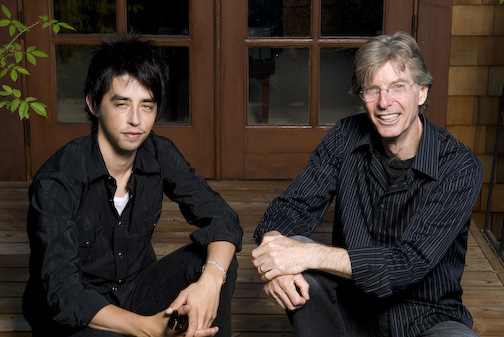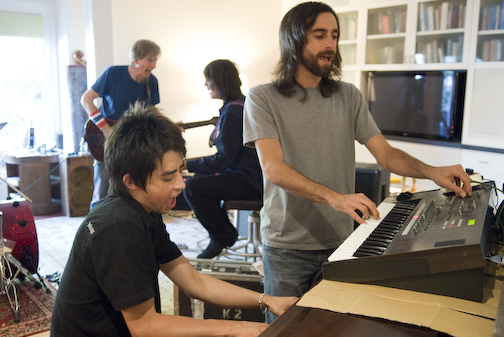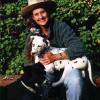
Jackie Greene and Phil Lesh.
Photo: Jay Blakesberg c. 2007
Ah yes, the glamorous life of a traveling musician! When I reach Jackie Greene on the phone in Missoula, Montana, in early August, he’s literally folding his underwear at a laundromat. “Unfortunately it doesn’t magically do itself,” he notes wryly. That night he was set to play an acoustic duo gig with guitarist Nathan Dale, who’s also in Greene’s regular band, as part of two-plus week swing that zig-zagged him to such far-flung ports-of-call as Minneapolis (on the day of the bridge collapse), New York, Chicago, San Jose, Montana, Idaho and even Alberta, Canada. Chart it on a map and it looks like one of those spiders-on-acid webs!
Count me among the many who were surprised (but delighted) to learn that this extremely talented 26-year-old singer-songwriter was tapped by Phil Lesh to become the main singer and second guitarist in the latest version of the ever-mutating Phil Lesh & Friends, whose fall tour stretches from September 22 through November 10. (You can see the complete tour list here). Over the course of three guerrilla getting-to-know-each-other gigs in small venues in the Bay Area in July, Greene looked and sounded fairly comfortable in what for him is a completely new musical milieu: This is a guy who had never played Grateful Dead music before, yet he sang and played with tremendous conviction, and a smattering of his own songs fit into the repertoire amazingly well. Clearly, Phil liked what he heard; hence the invitation to join with lead guitarist Larry Campbell (who by now has earned official P&F “wily veteran” status), recent keyboardist Steve Molitz and founding drummer John Molo in the fall edition of the group.
So, who is this guy anyway? Well, Jackie grew up near Placerville, California, a small Gold Rush town (originally known as Hangtown!) in the foothills of the Sierra. “I started playing in Placerville at coffee houses and pubs when I was 18,” Jackie says, “though my first gig was actually in Sacramento when I was 16. A blues cover band invited me to come play guitar with them; I forget their name at the moment. Before that, I played in garage bands during middle school and mostly did modern—at the time—stuff, a la Pearl Jam, etc. I didn't start seriously writing until I was about 18 or so.”
After high school he moved to Sacramento and over time he established a name for himself as one of the most interesting singer-songwriters on the local scene. Though his style was perhaps most clearly influenced by Bob Dylan—you can especially hear it on songs where he plays both acoustic guitar and harmonica—he also absorbed many other influences on his way to developing a recognizable oeuvre of his own, from Ray Charles to Muddy Waters to Hank Williams to Leadbelly to The Band. “When I got to Sacramento,” he said in a 2006 interview, “I just started playing all the time, just about every place I could possibly play. I’d play five or six nights a week; some nights I’d play a solo happy-hour gig from 4 to 7, then run across town and play a gig with my band. I busted my balls, and it worked. I learned quite a bit in a short period of time, and people started noticing.”

Jackie and Steve Molitz work out a part, while Phil and
Larry Campbell handle their end of an arrangement.
Photo: Jay Blakesberg c. 2007
Jackie had recorded his first album, a DIY effort called Rusty Nails, while still in high school. Once he started to get some attention in Sacramento, however, he signed a deal with a local indie label called Dig Music, and took on Dig’s owner, Marty DeAnda, as his manager. The first album he made for Dig, 2002’s Gone Wanderin’, immediately showed that this 21-year-old was a force to be reckoned with. With a wisdom and maturity far beyond his years, he also showed considerable instrumental acumen, playing both electric and acoustic guitar, harmonica, banjo and keyboards. (He sang two songs from that album—the title track and “Down in the Valley Woe”—at his initial P&F shows.) On his next release, Sweet Somewhere Bound (2004), he played nearly every instrument, including drums and synthesizers, and that album created enough of a buzz that it was licensed from Dig to the larger, New York-based Verve/Forecast label, and increasingly Jackie landed plum touring gigs opening for established artists. (My own initiation to Jackie’s artistry came at a 2005 Los Lobos show at the Fillmore. I’d never heard of him, but just one solo set by him turned me into a rabid fan. He received one of the best receptions for an “unknown” opening act I’ve ever seen; he blew away many people that night!)
In 2006, he put out the album that is the true masterwork of his brief career to date: American Myth, produced by Los Lobos’ Steve Berlin for Verve/Forecast, beautifully melds Greene’s different musical personalities into a stunning whole. It has rockin’ band-oriented tunes, sparser folk numbers, and perhaps his most magnificent nod to Dylan’s influence, the nine-minute epic “Supersede.” (Jackie also has an actual Dylan tribute album in his catalog, as well—a superb live disc called Positively 12th and K—that’s in Sacramento, folks, not Greenwich Village—on which he trades lead vocals with legendary Beau Brummels singer (and Sacto resident) Sal Valentino on a great selection of old and more recent Dylan tunes. You can find that, and a recently released compilation of Jackie’s earlier work called The Dig Years at www.digmusic.com.)
So how does Phil Lesh come into the picture? Jackie had seen Phil & Friends play live on the tour they did with Dylan a few years ago (Larry Campbell was in Dylan’s band back then!), but they didn’t meet. As Jackie tells it, “Phil had said some really nice things about American Myth and somebody forwarded his comments to me. Also, he was at Bonnaroo the same time we were there and he came to watch us play, and though I didn’t get to meet him at the show, somehow I got his manager’s e-mail address—that’s his wife, Jill—and I said, ‘Thanks for saying nice things about me.’ That was about a year ago, and I didn’t hear anything back, which was fine—I wasn’t expecting anything. Then, about six months ago my phone rings: ‘Jackie. Phil Lesh. Say, listen, I was thinking maybe you could help me work on some music.’ At first I thought it was a joke: ‘C’mon, Gimme a break!’ But I discovered it actually was Phil, and he came over to the little studio I have in San Francisco, and I actually bought him dinner. Then we hung out and started playing songs down in my studio space. After that I started going over to his house and hanging out there and playing songs. The next thing I know he asked me to be a ‘Friend’ for the fall, and of course I said yes.”
Greene says he had little previous experience with Grateful Dead music, other than hearing some records his parents owned. “I knew some of the big songs, and I liked them, but up until recently I’d never dived head first into this immense catalog. It’s really interesting to me now. I’m kind of like the rookie, I guess.” And though he has some background playing improvisational music—jazz piano and the like—“nothing that I’ve done compares to the way Phil plays. I don’t have experience jamming in that way, which makes it all the more exciting to me, really. It’s great being on the edge of what could be a train wreck at any moment, but somehow the band manages to figure it out on the spot. It’s really exciting. Sometimes I feel like an audience member watching them, thinking ‘Holy shit! How’d they do that?’” he laughs.
“The odd key changes and odd times are definitely stuff I’m not particularly used to, and before we started playing these warm-up gigs, I was sort of fearful of it: ‘I don’t know what I’m going do. I don’t know if I can hang with these guys.’ Then we did the first gig and I thought, ‘That’s not too bad; in fact it’s really fun.’ Phil gave me the best advice—he told me, ‘You just have to give yourself permission to do it.’ And that’s really true, because a lot of musicians worry about what everybody else is going to think about it, and they don’t give themselves permission to ‘step out.’ That’s always been my problem a little, and Phil sort of fixed that with one line.”
How is he learning the repertoire? “I learn by ear. Phil’s been great in that he confers with me on what songs I’d like to sing and whatnot. I have a stack about waist high of stuff and I’m listening to it all the time. I’m constantly discovering songs and falling in love with them. Like, I knew ‘Sugaree’ before, but I’d never really gotten into it and now it’s one of my favorite songs. I love singing it—I can howl on it; it’s great! Anyway, in that stack there might be ten different versions of ‘Sugaree’—one from Rochester and one from some other place, and so on, and I listen to them and I think, ‘Here’s the 11-minute version and here’s the 4-minute version: what happens in the 11-minute version to make it what it is? Oh, that’s weird!’ I try to learn the song first, obviously: It’s got this melody, this vibe. Then, from there on out it’s anybody’s game. We can get crazy with it, as Phil likes to do.
“Just recently, as of two night ago, I’ve been learning ‘Brokedown Palace,’ and loving that. Surprisingly, I really like the record version of that, which is kind of slow and acoustic. I want to try and sing that. I was just listening to ‘China Doll’ and that’s a beautiful song, too. I really like ‘Deal,’ which we’ve been singing, and I really like doing ‘New Speedway Boogie,’ because I can play harmonica on it. We’re going to do ‘Wharf Rat’…just lots and lots of songs, so I’ve got my work cut out for me. And this band just cooks on everything, so you’ve got to bring you’re A-game.”
He says that everyone in the group has been very encouraging to him so far, particularly Larry Campbell, “who can really play his ass off in any style. He’s so good. But then they’re all really great musicians and really nice people. John Molo is this big, powerful man, but personally he’s very gentle; very sweet. Everyone has been so helpful.”
Interestingly, it has been Phil who has selected which of Jackie’s songs to cover in the group, and so far they’ve ranged from the funky blues of “Seven Jealous Sisters,” to the beautiful, folkish “When You’re Walkin’ Away.” Other Greene originals P&F tackled in July include “I’m So Gone,” “So Hard to Find My Way,” and the aformenetioned “Gone Wanderin’” and “Down in the Valley Woe.” No doubt others will be unveiled over the course of the fall tour. When I plead for him to play “Supersede” at the Greek Theater, he chuckles and says, “Ooo—the long one! This band could definitely play that well.’”
Of course Grateful Dead music will continue to be the main focus of P&F’s performances, and Greene says he takes his responsibility for doing justice to the repertoire very seriously: “This music is sacred to so many people, and I can really see why—it’s amazing! I was talking to a friend who’s around my age—26—and we were saying, ‘We’ll probably never know how much these songs might mean to some people.’ It’s a trip to think about it that way—and also a little scary. It’s a heavy task. It’s a challenge and I want do really well. More than anything else I feel very honored to be playing with Phil & Friends. I have a tremendous amount of respect for Phil, the band and, of course, the songs. I'm actually still totally amazed at the idea of it.
"I'm going to do my best to honor these timeless songs.”
For more on Jackie Greene, check out his website at www.jackiegreene.com




